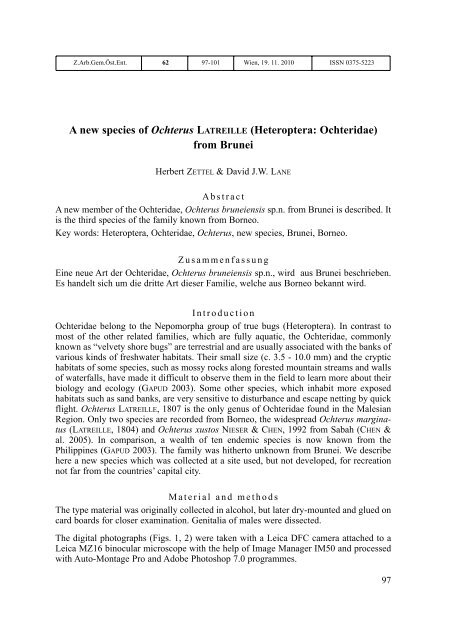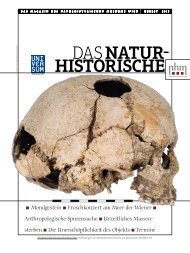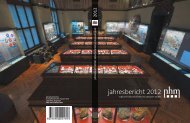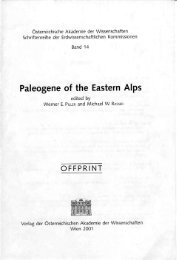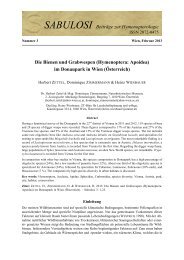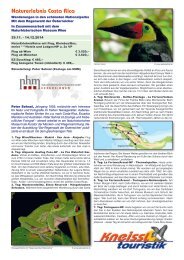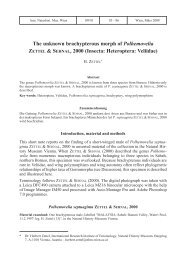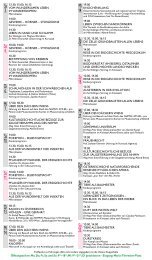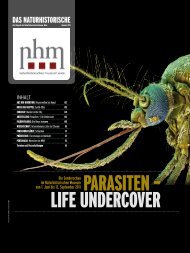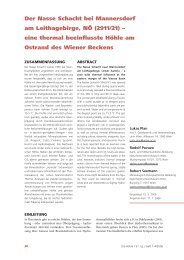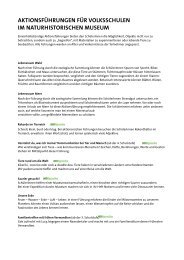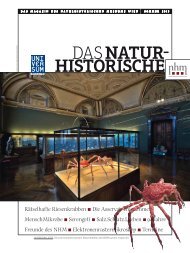A new species of Ochterus LATREILLE (Heteroptera: Ochteridae ...
A new species of Ochterus LATREILLE (Heteroptera: Ochteridae ...
A new species of Ochterus LATREILLE (Heteroptera: Ochteridae ...
You also want an ePaper? Increase the reach of your titles
YUMPU automatically turns print PDFs into web optimized ePapers that Google loves.
Z.Arb.Gem.Öst.Ent. 62 97-101 Wien, 19. 11. 2010 ISSN 0375-5223<br />
A <strong>new</strong> <strong>species</strong> <strong>of</strong> <strong>Ochterus</strong> <strong>LATREILLE</strong> (<strong>Heteroptera</strong>: <strong>Ochteridae</strong>)<br />
from Brunei<br />
Herbert ZETTEL & David J.W. LANE<br />
Abstract<br />
A <strong>new</strong> member <strong>of</strong> the <strong>Ochteridae</strong>, <strong>Ochterus</strong> bruneiensis sp.n. from Brunei is described. It<br />
is the third <strong>species</strong> <strong>of</strong> the family known from Borneo.<br />
Key words: <strong>Heteroptera</strong>, <strong>Ochteridae</strong>, <strong>Ochterus</strong>, <strong>new</strong> <strong>species</strong>, Brunei, Borneo.<br />
Zusammenfassung<br />
Eine neue Art der <strong>Ochteridae</strong>, <strong>Ochterus</strong> bruneiensis sp.n., wird aus Brunei beschrieben.<br />
Es handelt sich um die dritte Art dieser Familie, welche aus Borneo bekannt wird.<br />
Introduction<br />
<strong>Ochteridae</strong> belong to the Nepomorpha group <strong>of</strong> true bugs (<strong>Heteroptera</strong>). In contrast to<br />
most <strong>of</strong> the other related families, which are fully aquatic, the <strong>Ochteridae</strong>, commonly<br />
known as “velvety shore bugs” are terrestrial and are usually associated with the banks <strong>of</strong><br />
various kinds <strong>of</strong> freshwater habitats. Their small size (c. 3.5 - 10.0 mm) and the cryptic<br />
habitats <strong>of</strong> some <strong>species</strong>, such as mossy rocks along forested mountain streams and walls<br />
<strong>of</strong> waterfalls, have made it difficult to observe them in the field to learn more about their<br />
biology and ecology (GAPUD 2003). Some other <strong>species</strong>, which inhabit more exposed<br />
habitats such as sand banks, are very sensitive to disturbance and escape netting by quick<br />
flight. <strong>Ochterus</strong> <strong>LATREILLE</strong>, 1807 is the only genus <strong>of</strong> <strong>Ochteridae</strong> found in the Malesian<br />
Region. Only two <strong>species</strong> are recorded from Borneo, the widespread <strong>Ochterus</strong> marginatus<br />
(<strong>LATREILLE</strong>, 1804) and <strong>Ochterus</strong> xustos NIESER & CHEN, 1992 from Sabah (CHEN &<br />
al. 2005). In comparison, a wealth <strong>of</strong> ten endemic <strong>species</strong> is now known from the<br />
Philippines (GAPUD 2003). The family was hitherto unknown from Brunei. We describe<br />
here a <strong>new</strong> <strong>species</strong> which was collected at a site used, but not developed, for recreation<br />
not far from the countries’ capital city.<br />
Material and methods<br />
The type material was originally collected in alcohol, but later dry-mounted and glued on<br />
card boards for closer examination. Genitalia <strong>of</strong> males were dissected.<br />
The digital photographs (Figs. 1, 2) were taken with a Leica DFC camera attached to a<br />
Leica MZ16 binocular microscope with the help <strong>of</strong> Image Manager IM50 and processed<br />
with Auto-Montage Pro and Adobe Photoshop 7.0 programmes.<br />
97
Drawings (Figs. 3 - 5) were prepared with the help <strong>of</strong> a camera lucida attached to binocular<br />
microscopes (Leica Wild M10, Nikon SMZ 1500).<br />
Terminology follows GAPUD (2003) and CHEN & al. (2005).<br />
<strong>Ochterus</strong> bruneiensis sp.n. (Figs. 1 - 5)<br />
Type material: Holotype (male), labelled “Brunei: Brunei/Muara\ Sg. Akar, water fall<br />
area\ 22.11.2008, N 04°56’\ E 114°59’, 47m GPS\ leg. H. Zettel (16)”, deposited in the<br />
Brunei Museum. Paratypes: 3 males, 2 females, same label data as holotype, in the<br />
Natural History Museum Vienna and in the Biology Department, Universiti Brunei<br />
Darussalam.<br />
Type locality and habitat: Brunei, Brunei-Muara District, Sungai Akar, waterfall area<br />
near main road, 47 m a.s.l., N 04°56’45” E 114°59’13” (GPS), collected from small sand<br />
bank at a narrow, slowly flowing stream in sand stone area, meandering through secondary<br />
rainforest.<br />
Diagnosis: Very small (3.8 - 3.9 mm), more slender than most congeners. Pronotum and<br />
sides <strong>of</strong> forewings with orange marks. Forewings with fine pattern <strong>of</strong> numerous small<br />
frosted spots (Fig. 1). Frontal plate with long median carina and with numerous fine,<br />
transverse, more or less irregular wrinkles (Fig. 2). – Male: Forefemur with very long<br />
pilosity at basal three fourths <strong>of</strong> flexor side. Process <strong>of</strong> pygophore long and slender (Fig.<br />
3). Right appendage <strong>of</strong> right paramere vestigial, left one long and slender (Fig. 4). –<br />
Female: Subgenital plate with shallow medial emargination (Fig. 5).<br />
Description <strong>of</strong> male: Size: Body length 3.79 - 3.82 mm. Maximum body width approximately<br />
at midlength <strong>of</strong> forewings, 1.98 - 2.03 mm. Head width 1.13 - 1.15 mm. Pronotum<br />
width 1.84 - 1.91 mm.<br />
Colour: Dorsum (as in female, Fig. 1) black to dark brown; pronotum with orange sides<br />
(anteriorly yellowish) and orange mark at middle <strong>of</strong> hind margin; embolium with broad<br />
membrane with very narrow yellow to orange margin; entire forewings speckled with<br />
irregular, grayish-white frosted marks. Eyes dark red or silverish (as in female, Fig. 2);<br />
frontal plate with yellowish white anterior margin. Labrum, buccula and rostrum orange<br />
to brownish orange. Antennomeres 1 and 2 yellowish white, 3 and 4 brown. Venter <strong>of</strong><br />
body dark brown, large areas on abdomen rather orange brown. Acetabula with yellowish<br />
margins (broad at proacetabula, narrow at others). Legs yellow, apices <strong>of</strong> femora, tibiae<br />
and tarsi narrowly infuscated (<strong>of</strong>ten inconspicuous).<br />
Structures (measurements refer to holotype): Body generally <strong>of</strong> elongate shape (Fig. 1).<br />
Head (Fig. 2) with very large eyes, smallest interocular distance 0.30 times head width.<br />
Vertex dull. Frontal plate (as in female, Fig. 2) with long median carina, ending in short<br />
distance from anterior margin (approximately at transition to yellowish anterior margin);<br />
with inconspicuous longitudinal carinae along dorsal eye margins, and with numerous<br />
fine, transverse wrinkles; these wrinkles anteriorly more regular than posteriorly; yellow<br />
anterior margin, smooth, without wrinkles. Lengths <strong>of</strong> antennomeres 1 - 4 (Fig. 2), 0.09,<br />
0.12, 0.27, 0.34 mm, antennomeres 1 and 2 distinctly thicker than 3 and 4. Rostrum long,<br />
surpassing hind coxae by length <strong>of</strong> last segment.<br />
Pronotum strongly transverse, width 2.4 times median length; anterolateral angles blunt;<br />
anterolateral depressions deep and slender; lateral margins weakly convex; posterior margin<br />
trisinuate; on disk with deep punctures, on collar with few small punctures, on sides<br />
without punctures. Mesoscutellum sparsely punctured. Hemielytron unevenly punctured;<br />
98
on clavus with few punctures mostly along margins; on endocorium with numerous punctures<br />
mostly at base; on embolium with numerous punctures on medial part. Forefemur<br />
with very long pilosity at basal three fourths <strong>of</strong> flexor side.<br />
Abdominal segments 7 and 8, and genitalia strongly assymmetrical. Pygophore with long,<br />
comparatively narrow, apically rounded process (Fig. 3) beset with very long pilosity.<br />
Right paramere (Fig. 4) with apically broadly rounded capitulum; hood fairly densely<br />
punctate and rounded; right appendage triangular and very small; left appendage long and<br />
slender, slightly widened towards apex, without incision, almost parallel with slender<br />
shaft.<br />
Description <strong>of</strong> female: Size: Body length 3.88 - 3.90 mm. Maximum body width<br />
approximately at midlength <strong>of</strong> forewings, 2.08 - 2.14 mm. Head width 1.14 - 1.15 mm.<br />
Pronotum width 1.94 - 1.98 mm.<br />
Colour (Fig. 1) and structural characteristics as in male except for the following:<br />
Distance between eyes slightly larger (0.35 times head width, Fig. 2) and pronotum marginally<br />
wider (2.5 times median length, Fig. 1) than in male. Forefemur without long<br />
pilosity (Fig. 2). Abdomen symmetrical. Sternite 7 (Fig. 5) slightly folded and strongly<br />
narrowed posteriorly; medial hind margin slightly concave, sides with 2+2 long setae near<br />
base.<br />
Comparative notes: In <strong>Ochterus</strong> the structures <strong>of</strong> the capitulum <strong>of</strong> the males’ right parameres<br />
yield most important characteristics for <strong>species</strong> distinction. A vestigial, triangular<br />
right appendage as in O. bruneiensis sp.n. (Fig. 4) is unknown from any described <strong>species</strong><br />
in the whole western Malesian Region (compare GAPUD & SAN VALENTIN 1977, GAPUD<br />
1981, 1995, 2003, NIESER & CHEN 1999). In some <strong>species</strong>, like O. grandiusculus NIESER<br />
& CHEN, 1992 from Sulawesi and O. xustos from northern Borneo (see NIESER & CHEN<br />
1999) where the right appendage is relatively short, but still elongated, both appendages<br />
are <strong>of</strong> similar length. The long median carina on the frontal plate (Fig. 2), which almost<br />
reaches its anterior margin, distiguishes O. bruneiensis sp.n. from most congeners in the<br />
region, including the most common <strong>species</strong>, O. marginatus. <strong>Ochterus</strong> xustos from northern<br />
Borneo, which has a similar long carina, is much larger in body size (length 4.3 - 4.7<br />
mm).<br />
Acknowledgements<br />
The authors wish to thank the University Research Committee <strong>of</strong> Universiti Brunei<br />
Darussalam for approval <strong>of</strong> a collaborative research project on the water bugs <strong>of</strong> Brunei;<br />
Harald Bruckner for help in producing the phototgraphs (Figs. 1, 2).<br />
REFERENCES<br />
CHEN P.-P., NIESER N. & ZETTEL H., 2005: The aquatic and semi-aquatic bugs (<strong>Heteroptera</strong>:<br />
Nepomorpha & Gerromorpha) <strong>of</strong> Malesia. – Fauna Malesiana Handbooks 5, Brill, Leiden –<br />
Boston, 546 pp.<br />
GAPUD V.P., 1981: Contribution to the taxonomy <strong>of</strong> the genus <strong>Ochterus</strong> <strong>LATREILLE</strong> (Hemiptera:<br />
<strong>Ochteridae</strong>). – Kalikasan, Philippine Journal <strong>of</strong> Biology 10(2-3): 300-309.<br />
GAPUD V.P., 1995: A <strong>new</strong> <strong>species</strong> <strong>of</strong> <strong>Ochterus</strong> <strong>LATREILLE</strong> (Hemiptera: <strong>Ochteridae</strong>) from the Philippines.<br />
– Asia Life Sciences 4(1): 41-44.<br />
GAPUD V.P., 2003: Two <strong>new</strong> Philippine <strong>Ochterus</strong> <strong>LATREILLE</strong> (Insecta: <strong>Heteroptera</strong>: <strong>Ochteridae</strong>) and<br />
checklist <strong>of</strong> Philippine <strong>species</strong>. – Annalen des Naturhistorischen Museums in Wien, Serie B,<br />
104 (2002): 99-108.<br />
99
GAPUD V.P. & SAN VALENTIN H.O., 1977: The <strong>Ochteridae</strong> (Hemiptera) <strong>of</strong> the Philippines. –<br />
Kalikasan, Philippine Journal <strong>of</strong> Biology 6(3): 269-300.<br />
NIESER N. & CHEN P.P., 1999: Sixteen <strong>new</strong> <strong>species</strong> <strong>of</strong> Nepomorpha mainly from Sulawesi. Notes<br />
on Malesian aquatic and semiaquatic bugs (<strong>Heteroptera</strong>), VIII. – Tijdschrift voor Entomologie<br />
142: 77-123.<br />
Authors’ addresses:<br />
Dr. Herbert ZETTEL, Entomological Department, Natural History Museum, Burgring 7,<br />
1010 Vienna, Austria.<br />
herbert.zettel@nhm-wien.ac.at<br />
100<br />
Dr. David J.W. LANE, Department <strong>of</strong> Biology, Universiti Brunei Darussalam, Jalan<br />
Tungku Link BE1410, Brunei Darussalam.<br />
david.lane@ubd.edu.bn<br />
Figs. 1 - 5: <strong>Ochterus</strong> bruneiensis sp.n., paratypes: (1) Habitus <strong>of</strong> female, dorsal aspect. (2) Head <strong>of</strong><br />
female, frontal aspect. (3) Process <strong>of</strong> pygophore <strong>of</strong> male, caudoventral aspect. (4) Capitulum <strong>of</strong><br />
right paramere <strong>of</strong> male, frontal aspect (h – hood, la – left appendage, ra – right appendage). (5)<br />
Subgenital plate (sternite 7) <strong>of</strong> female, ventral aspect. Figures 1-2: © NHMW Hemiptera Image<br />
Collection, published with permission.
101


